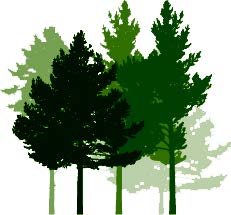Search technical reports
Summary of Tests on Untreated Douglas-fir, Treated and Untreated Radiata pine for Use as Framing in Domestic Construction in New Zealand
By M Hedley, D Page and J van der Waals, February 2011.
Download FFR-DS029 (pdf)
Executive summary
The aftermath of the “Leaky Building Crisis” of the late 1990s to early 2000s led to a raft of changes in building standards, with particular reference to preservative treatment requirements for some framing components. The intention of the treatment was to offer temporary decay resistance, should a building leak, until such time as the leak was identified and rectified. Framing durability would still be based on the concept of the timber not attaining a moisture content suitable for decay during the life of the building, i.e. it would remain at a moisture content below 20%.
Limited scope remained for use of untreated framing in low risk locations within a building, e.g. internal walls. Although untreated Douglas-fir had been used successfully for many years, mostly for exterior framing and cladding combinations. Its use in exterior walls was now restricted to single story buildings with masonry veneer cladding. In other respects, Douglas-fir was considered to be no different to radiata pine and was required to be preservative treated when used in situations where radiata pine was required to be treated.
This ruling caused considerable disquiet among Douglas fir growers and manufacturers of Douglas fir framing who were of the belief that expected performance of untreated Douglas fir could be considered more closely equivalent to expected performance of H1.2 treated radiata pine than to that of untreated radiata pine.
These differences of opinion led to the development of this suite of studies to determine the relative durability position of untreated Douglas fir vis à vis untreated radiata pine and H1.2 treated radiata pine.
This report will summarise six different trails conducted at Scion between 2003 and 2009 in addition, an independent audit of the literature comparing Douglas-fir to untreated and treated radiata pine was undertaken by Dr. Paul Morris from FPInnovations, Canada. His conclusions are summarised.
Trial 1: Ten lengths of Douglas-fir and six lengths of radiata pine were exposed to natural rainfall in Rotorua over 55 days in winter 2003. From an initial mean moisture content of 11 and 15% for radiata pine and Douglas-fir, respectively, the moisture levels rose to 35% and 20%. The Douglas fir never reached the threshold 27% moisture content (required to initiate decay) and proved to be much more difficult to wet that the radiata pine.
Trial 2: radiata pine and Douglas-fir sapwood and heartwood samples were dried to a common moisture content and then hung outside vertically or horizontally for 55 days. The moisture content of horizontally-positioned wood increased 7.1% compared with vertically-positioned wood. The Douglas-fir had a 6.6% or 0.9% lower moisture content for horizontally or vertically-positioned radiata pine wood, respectively. Radiata pine and Douglas-fir heartwood samples contained 5.2% or 1.8% lower moisture content than sapwood samples.
Trial 3: The stability of Douglas-fir and radiata pine structural timber was assessed when subjected to moisture cycling. Stud length samples and Douglas-fir and radiata pine were exposed to repeated wetting and drying. The radiata pine showed the greatest permeability but warping was not important for either species. The greatest timber instability was for green Douglas-fir during the drying phase prior to the trial starting.
Trial 4: Decay resistance testing. Model house frame units were made that simulated walls that are exposed to moisture. All untreated radiata pine units failed after 1.5 years and all untreated Douglas-fir samples failed after three years. Boron-treated radiata pine samples showed decay resistance for greater than five years.
Trial 5: The durability of Douglas-fir was compared with approved framing species and timber treatments. Untreated sapwood samples from all species showed appreciable decay after three years. Macrocarpa and Larch heartwood samples showed slower rates of decay than samples from radiata pine Douglas-fir and Lawson cypress. Boron treated sapwood showed no decay. Untreated sapwood of all species should not be used in areas where framing might become wet.
Trial 6: Progress of decay and stiffness loss with time in Douglas-fir and radiata pine. Samples of untreated radiata pine and Douglas-fir heartwood and sapwood as well as treated radiata pine were placed in a moisture tank and tested for water uptake, decay, mould and deflection every 4-8 weeks over the period of one year. Untreated radiata pine sapwood decayed rapidly. Heartwood had both greater decay resistance an showed less deflection compared with sapwood samples. Douglas-fir heartwood, in particular despite the presence of observable decay, did not show any stiffness loss. This suggests that the presence of observable decay – the main criterion for replacement of framing when a “leaky building” is rehabilitated – may not reflect residual stiffness, which could be retained when leaks were rectified and the framing dried.
Conclusions of Dr Paul Morris of FPInnovations, Canada.
The durability of treated and untreated radiata pine and Douglas-fir in New Zealand wood frame buildings was compared. The main conclusions were:
- The current requirements for five years protection would only be provided by boron treatment
- If the required protection period were shortened to 2-3 years, a Douglas-fir heartwood product would provide adequate decay resistance
- Untreated Douglas-fir sapwood would not be assured to provide two year protection
- The minimum probable times from leak initiation to unacceptable decay (following periodic wetting) may be:
- ≤1 year Untreated radiata pine sapwood
- 1.5-2.7 years Untreated Douglas-fir sapwood
- 3-6 years Untreated Douglas-fir heartwood
- >5 years Boron treated radiata pine sapwood
While Douglas-fir heartwood could not be regarded as equivalent to H1.2 treated radiata pine, it was superior to untreated radiata pine, particularly in low/medium risk situations.
On the basis of these trials, the Department of Building and Housing has proposed to extend framing situations where Douglas-fir can be used untreated in low risk domestic constructions.

 Specialty Timbers New Zealand
Specialty Timbers New Zealand
No posts yet
Add a post